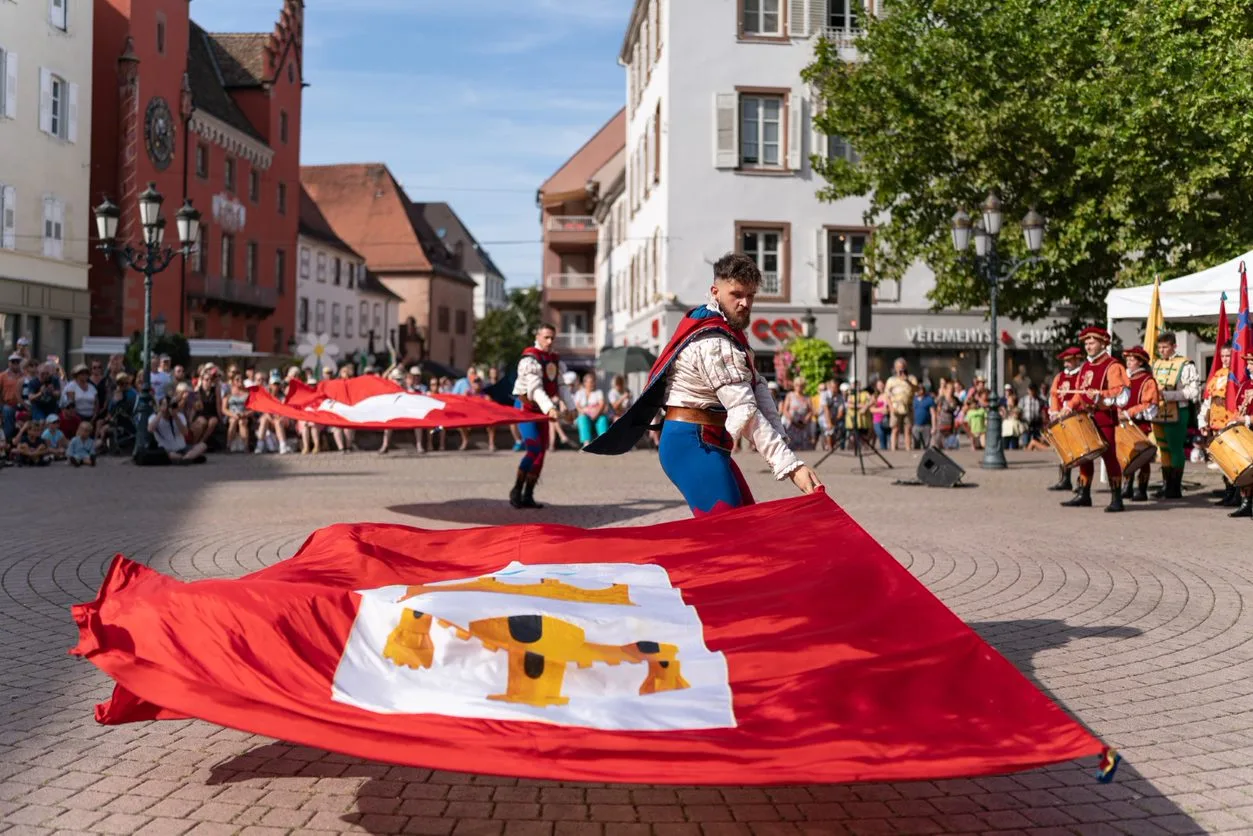The Flag
The History of the Flag
Today, we are all familiar with flags. Whether we identify with a team, a country, or want to convey a specific concept through flags, using designs, colors, and words. When did flags originate? When did flag-waving performers begin?
Antiquity: Flags and Flag-Waving Performers

Standard bearer from the 12th century, detail from the bas-reliefs of Porta Romana. Milan, Museum of Ancient Art of the Sforza Castle
Primitive flags were likely pieces of cloth attached to a pole, used to signal, communicate, and represent groups or nations. The Assyrians and Babylonians used symbols and banners in their ceremonies and battles as early as the second millennium BC. The ancient Hebrews also adopted flags as "signum belli" in war and as symbols of joy during peace ceremonies.
During the Roman Empire, flags, or "vexilla," were used to identify legions and coordinate troop movements. These banners were often decorated with symbols and images representing the legion or the emperor. Regarding civilian use of flags, the first flag-waving performers with improvised choreographies emerged in Cori as early as the second century. Cori is the hometown of the Sbandieratori dei Rioni di Cori, during Christian popular festivals that were spreading.
In 687 AD, the Roman people paid homage to the newly elected Pope Sergius I with flag-waving of drapes and banners. Since then, civil and religious processions, tournaments, jousts, and palios in Western Europe featured increasingly refined choreographies. Guilds also had standard bearers tasked with flag-waving during official ceremonies and assemblies. This tradition, supported by popular enthusiasm, continued in papal processions until the sixteenth century. Even in the East and the Islamic world, flags were widely used during celebrations of victories.
The Renaissance and the Birth of Flag-Waving Performers

During the Renaissance, the art of handling flags developed further, both in military and ceremonial contexts. In particular, standard bearers were responsible for carrying and maneuvering flags, demonstrating dexterity and acrobatic skill. Moreover, flag-waving performers had deep knowledge of the law, different cultures, and languages. In this sense, the flag-waver was a very dynamic figure who could decide the fate of a battle as well as act as a figure of peace and diplomacy. A crucial moment in codifying flag movements occurred in 1628 with the book “The Flag” by court master Francesco Ferdinando Alfieri. This text provided detailed instructions for cadets wishing to master this discipline, transforming it from a military technique into a refined artistic expression.
The Sbandieratori dei Rioni di Cori originate exactly from this tradition, inspired and guided by the principles and movements described in the book by master Francesco Ferdinando Alfieri. This folklore group perfectly embodies the legacy left by the master, performing shows that combine acrobatics, choreography, and Renaissance music. Their performances are a celebration of Italian history and culture, fascinating audiences worldwide with the beauty and precision of their flag movements.
 The Cori flag-waving school, distinguished by the use of wooden poles and wide drapes, faithfully follows the techniques illustrated in the seventeenth century. This style represents a direct continuity with Renaissance art, making the Sbandieratori dei Rioni di Cori custodians of an invaluable intangible heritage.
Over the centuries, the use of flags has evolved, becoming symbols of national identity, pride, and celebration. Today, flags are used worldwide to represent countries, organizations, and movements, keeping alive a millennia-old tradition that continues to fascinate and inspire.
The Cori flag-waving school, distinguished by the use of wooden poles and wide drapes, faithfully follows the techniques illustrated in the seventeenth century. This style represents a direct continuity with Renaissance art, making the Sbandieratori dei Rioni di Cori custodians of an invaluable intangible heritage.
Over the centuries, the use of flags has evolved, becoming symbols of national identity, pride, and celebration. Today, flags are used worldwide to represent countries, organizations, and movements, keeping alive a millennia-old tradition that continues to fascinate and inspire.
 The Cori flag-waving school, distinguished by the use of wooden poles and wide drapes, faithfully follows the techniques illustrated in the seventeenth century. This style represents a direct continuity with Renaissance art, making the Sbandieratori dei Rioni di Cori custodians of an invaluable intangible heritage.
Over the centuries, the use of flags has evolved, becoming symbols of national identity, pride, and celebration. Today, flags are used worldwide to represent countries, organizations, and movements, keeping alive a millennia-old tradition that continues to fascinate and inspire.
The Cori flag-waving school, distinguished by the use of wooden poles and wide drapes, faithfully follows the techniques illustrated in the seventeenth century. This style represents a direct continuity with Renaissance art, making the Sbandieratori dei Rioni di Cori custodians of an invaluable intangible heritage.
Over the centuries, the use of flags has evolved, becoming symbols of national identity, pride, and celebration. Today, flags are used worldwide to represent countries, organizations, and movements, keeping alive a millennia-old tradition that continues to fascinate and inspire.